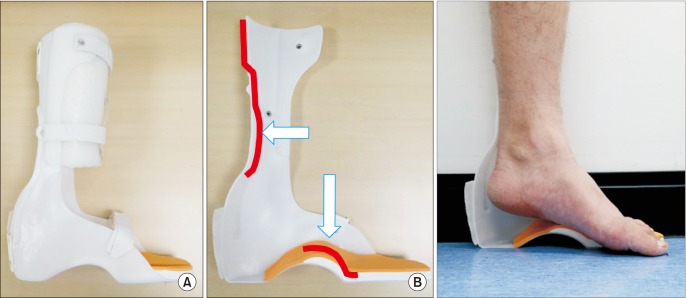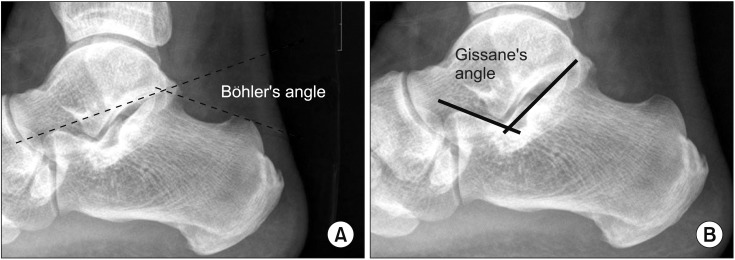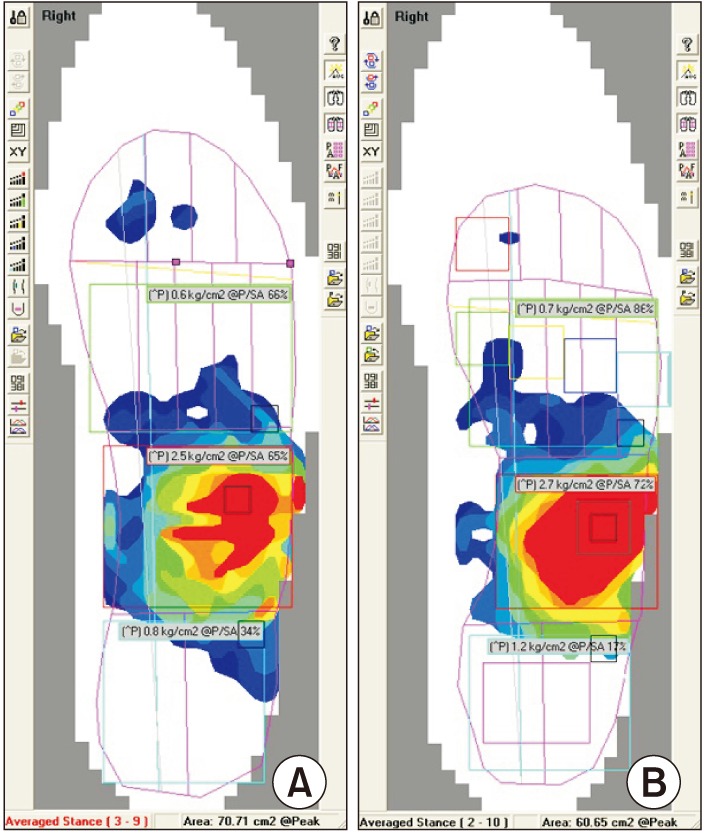Clin Orthop Surg.
2018 Sep;10(3):374-379. 10.4055/cios.2018.10.3.374.
Radiological and Clinical Effectiveness of a Novel Calcaneal Fracture Brace after Intra-articular Calcaneal Fracture Surgery
- Affiliations
-
- 1Department of Orthopaedic Surgery, Chungnam National University Hospital, Chungnam National University School of Medicine, Daejeon, Korea. faschan@daum.net
- KMID: 2418759
- DOI: http://doi.org/10.4055/cios.2018.10.3.374
Abstract
- BACKGROUND
After calcaneal fracture surgery, a short leg splint and cast are typically applied. However, these restrict joint exercises, which is inconvenient for patients. In addition, there is a risk of complications, such as pressure ulcers or nerve paralysis with a short leg cast. In this study, we evaluated clinical and radiological outcomes of the use of a specially designed calcaneal brace after calcaneal fracture surgery.
METHODS
From among patients who underwent open reduction and internal fixation for calcaneal fracture between July 9, 2013 and May 31, 2017, 102 patients who wore a calcaneal fracture brace (group A) and 82 patients who wore a postoperative short leg cast (group B) were randomly chosen for this study. Radiological changes and clinical factors were compared between the two groups. After swelling at the surgical site decreased, a special calcaneal brace was applied to patients in group A. They were allowed to perform early weight bearing and joint motion. Patients in group B were immobilized in a short leg cast and were told to avoid weight bearing for 6 weeks. In each group, the Böhler's angle and Gissane's angle were measured and compared using postoperative and final follow-up radiographs. Pain (measured using a visual analogue scale [VAS]) and ankle joint range of motion (dorsiflexion, plantar flexion, eversion, and inversion) were measured serially until the final follow-up visit.
RESULTS
There were no significant differences in the Böhler's angle or Gissane's angle between the two groups as measured postoperatively and at the final follow-up (paired t-test). Differences in the VAS pain score and eversion were also statistically nonsignificant between the two groups. However, group A had a significantly higher range of dorsiflexion (p = 0.021), plantar flexion (p = 0.012), and inversion (p = 0.045) of the ankle than group B (independent t-test).
CONCLUSIONS
Application of the calcaneal fracture brace after open reduction and internal fixation of a calcaneal fracture not only maintained the fracture reduction but allowed for greater joint motion than the short leg cast. Thus, the calcaneal fracture brace can be considered an effective postoperative management option that enables early resumption of daily activities and facilitates postoperative joint motion.
Keyword
MeSH Terms
Figure
Reference
-
1. Brauer CA, Manns BJ, Ko M, Donaldson C, Buckley R. An economic evaluation of operative compared with nonoperative management of displaced intra-articular calcaneal fractures. J Bone Joint Surg Am. 2005; 87(12):2741–2749. PMID: 16322625.
Article2. Buckley R, Tough S, McCormack R, et al. Operative compared with nonoperative treatment of displaced intraarticular calcaneal fractures: a prospective, randomized, controlled multicenter trial. J Bone Joint Surg Am. 2002; 84(10):1733–1744. PMID: 12377902.3. Agren PH, Wretenberg P, Sayed-Noor AS. Operative versus nonoperative treatment of displaced intra-articular calcaneal fractures: a prospective, randomized, controlled multicenter trial. J Bone Joint Surg Am. 2013; 95(15):1351–1357. PMID: 23925738.4. Griffin D, Parsons N, Shaw E, et al. Operative versus nonoperative treatment for closed, displaced, intra-articular fractures of the calcaneus: randomized controlled trial. BMJ. 2014; 349:g4483. PMID: 25059747.5. Stulik J, Stehlik J, Rysavy M, Wozniak A. Minimally-invasive treatment of intra-articular fractures of the calcaneum. J Bone Joint Surg Br. 2006; 88(12):1634–1641. PMID: 17159178.
Article6. Bruce J, Sutherland A. Surgical versus conservative interventions for displaced intra-articular calcaneal fractures. Cochrane Database Syst Rev. 2013; (1):CD008628. PMID: 23440830.
Article8. Ishikawa SN. Fractures and dislocations of the foot. In : Azar FM, Canale ST, Beaty JH, editors. Campbell's operative orthopaedics. 13ed. Philadelphia, PA: Elsevier;2017. p. 4276–4350.9. Agren PH, Mukka S, Tullberg T, Wretenberg P, Sayed-Noor AS. Factors affecting long-term treatment results of displaced intraarticular calcaneal fractures: a post hoc analysis of a prospective, randomized, controlled multicenter trial. J Orthop Trauma. 2014; 28(10):564–568. PMID: 24824095.10. Paul M, Peter R, Hoffmeyer P. Fractures of the calcaneum: a review of 70 patients. J Bone Joint Surg Br. 2004; 86(8):1142–1145. PMID: 15568527.11. Sanders R. Displaced intra-articular fractures of the calcaneus. J Bone Joint Surg Am. 2000; 82(2):225–250. PMID: 10682732.
Article12. Paley D, Hall H. Intra-articular fractures of the calcaneus: a critical analysis of results and prognostic factors. J Bone Joint Surg Am. 1993; 75(3):342–354. PMID: 8444912.
Article13. Raymakers JT, Dekkers GH, Brink PR. Results after operative treatment of intra-articular calcaneal fractures with a minimum follow-up of 2 years. Injury. 1998; 29(8):593–599. PMID: 10209590.14. Follak N, Merk H. The benefit of gait analysis in functional diagnostics in the rehabilitation of patients after operative treatment of calcaneal fractures. Foot and Ankle Surg. 2003; 9(4):209–214.
Article15. Halanski M, Noonan KJ. Cast and splint immobilization: complications. J Am Acad Orthop Surg. 2008; 16(1):30–40. PMID: 18180390.
Article16. Micheli LJ. Thromboembolic complications of cast immobilization for injuries of the lower extremities. Clin Orthop Relat Res. 1975; (108):191–195. PMID: 237645.
Article17. Kienast B, Gille J, Queitsch C, et al. Early weight bearing of calcaneal fractures treated by intraoperative 3D-fluoroscopy and locked-screw plate fixation. Open Orthop J. 2009; 3:69–74. PMID: 19750017.
Article18. Hyer CF, Atway S, Berlet GC, Lee TH. Early weight bearing of calcaneal fractures fixated with locked plates: a radiographic review. Foot Ankle Spec. 2010; 3(6):320–323. PMID: 20538916.
- Full Text Links
- Actions
-
Cited
- CITED
-
- Close
- Share
- Similar articles
-
- Surgical Treatment for Displaced Intra-Articular Calcaneal Fractures
- Operative Treatment of Calcaneal Fracture
- Management of Displaced Intra-articular Calcaneal Fracture
- Surgical Outcomes of Intra-articular Fractures of Calcaneus using AO Calcaneal Plate
- Comparison of F Calcaneal Plate and Locking Calcaneal Plate Fixation Using an Lateral Extensile Approach to Intra-articular Calcaneal Fractures




